 |
|
Wood
Bats 4 Sale
RockBats
RockBat
Composite
Wood and
Maple
Laminated
Baseball Bats |
|
 |
|
|
|
|
We sell wood bats and BBCOR.50 composite wood bats
and wood bats at
a fair price, we're not cheap and we're not
expensive.
Our price is just plain fair!
Our service is our pledge, we ship USPS
Priority Mail (2 day), and we want your
friends to order. |
|
|
|
|
|
More BBCOR.50 Bats for sale in the next few
weeks see
woodbats4sale for now. |
|
|
|
Bat shape. All of our Rock Bat models
that are available in solid-wood are now available in our all-wood
laminated composite design. If you feel that you can swing a big-barrel
bat with little drop in bat speed, then you can go for that "extra"
performance by trying our model RB 174C. This has the largest barrel
diameter, and if you are a strong player, and can swing this just as
fast... then you will get maximum performance out of this bat model.
NOTE: due to the thin-handle design, we only offer this bat model in
our laminated composite version - because it has HICKORY in the handle
of the bat.
Bat speed. we inserted an extra
lightweight wood in the core of our maple barrel, which reduces the
overall weight, and shifts the balance of the bat toward the hands
(yes, this is like a corked bat). We also inserted an extra-strong,
high-density wood in the core of our maple handle, which further shifts
balance toward the hands. The result: an engineered bat that will
provide more bat speed than a solid-wood bat having the same shape and
weight.
Material properties.To a lesser extent
than bat speed, the material properties that you put into a bat are
important. If you make a bat with high-stiffness wood, you will achieve
better performance (i.e. faster ball speed) compared to the same bat
with "average" wood in the handle. Too much flex in the handle is lost
energy - energy that could have bee transferred to the ball.
NOTE: Our RockBats are manufactured
using ALL-WOOD components. RockBats does not use fiberglass wraps,
fiber-reinforced plastic handles, or internal metal rods.
 
Tiger Stick Bat Grip
Be ready for Spring Baseball
order your
RockBat
Composite
Wood
Laminated
Baseball Bat
Today |
|
|
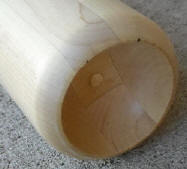 |
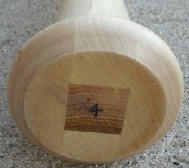 |
|
RockBat Wood
Laminated
Composite Design |
|
|
|
|
LRB-271
Rock Bat Wood
laminated composite design |
LRB-331Rock
Bat Wood
laminated composite design |
|
|
|
|
LRB-243
Rock Bat Wood
laminated composite design |
LRB-174
Rock Bat Wood
laminated composite design |
|
|
|
The First Angled-Knob Bat Ever Used in an MLB Game Goes to Cooperstown.
Pro XR Ergonomic Bat, U.S. Patent 7,744,497
ST. LOUIS (Oct. 13, 2011) – Two baseball bats featuring an ergonomically
correct angled knob were recently accepted into The National Baseball Hall
of Fame. The bats were first used in an official MLB competition on Sept. 5,
2010 by then New York Mets infielder, Mike Hessman, who hit a double to the
left field wall at Wrigley Field in a game against the Chicago Cubs.
“I’m shocked and excited. It’s a blessing to be part of history. I’m glad I
decided to use it that day,” said Hessman after learning of the significance
of his stand-up double with the new ProXR design. “The bat felt great in the
game. You always feel better when the bat feels good in your hand,” said
Hessman. Five days after Hessman’s hit, Milwaukee Brewers’ Prince Fielder
successfully used the same ProXR angled knob technology in a series of
games.
St. Louis-based designer and inventor Grady Phelan developed the patented
ProXR™ angled-knob bat technology to improve grip, performance and bat
speed. “Seeing Mike Hessman hit a double with my ProXR bat was tremendous
validation for this new design. Having that bat accepted into the Baseball
Hall of Fame is a huge honor,” said Phelan. |
|
|
|
Fungo Bat
Fungo bats are specially designed for
fielding practice and/or training. The 35" fungo is typically used by
coaches for hitting fly balls to outfielders.
Every RockBat Fungo has the Major League ink spot on the handle and the
sweet spot identification on the barrel. Coaches can utilize these features
as an excellent teaching tool when discussing wood bats with young players.
Order your Rock Bat Wood
Composite |
|
|
Be ready for Spring Baseball order
your Rock Bat
| |
RB
243 |
RB
271 |
RB
331 |
RB
174 |
|
Bat Design |
Balanced
Large barrel
Thick handle |
Balanced
Medium barrel
Medium handle |
Super-Balanced
Medium barrel
Medium handle |
End-weighted
XL barrel
Thin handle |
|
Knob Design |
Medium Knob
Moderate flare |
Medium Knob
Moderate flare |
XL Knob
Large flare |
Medium Knob
Light flare |
|
Taper Design |
Fast Taper |
Long, Slow Taper |
Moderate Taper |
Fast Taper |
|
Species |
Hard Maple |
Hard Maple |
Hard Maple |
Hard Maple |
|
Barrel Size |
Large |
Medium |
Medium |
Large |
|
Handle Size |
Thick |
Medium |
Medium |
Thin |
|
Comparable Model |
M110/C243 |
C271 |
C331 |
G174 |
|
Lengths |
32", 33", 34" |
32", 33", 34" |
32", 33", 34" |
33", 34" |
|
Weight Drops |
-3 |
-3 |
-3 |
-2 |
|
Barrel Cup |
Yes |
Yes |
Yes |
Yes |
|
About RockBats
Be sure to visit our other informational site:
http://www.woodbat.org/
Where you can learn more about wood quality and wood
baseball bats
Our Background
You've probably read all the stories
about former players, former carpenters,
former bat reps, or even former sawmills
deciding to start their own maple baseball
bat business. At RockBats, we have a
different story to tell.
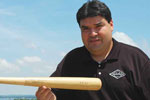 RockBats was founded by Roland Hernandez -
a Research Wood Scientist from the USDA
Forest Products Laboratory - the national
research laboratory of the Forest Service
located in Madison, Wisconsin. Read more
about the Forest Products Laboratory at
their
website.
RockBats was founded by Roland Hernandez -
a Research Wood Scientist from the USDA
Forest Products Laboratory - the national
research laboratory of the Forest Service
located in Madison, Wisconsin. Read more
about the Forest Products Laboratory at
their
website.
For over 17 years, Roland was a government
researcher in the area of structural
engineered wood products - primarily
glued-laminated timber. His research
involved (1) Utilization, (2) Analysis, and
(3) Optimization of wood materials for the
development of viable structural wood
products. One utilization project involved
taking small-diameter Ponderosa pine forest
thinnings and making usable structural
glued-laminated timber beams (click here to
read that Forest Service report). Analysis
projects involved interpreting laboratory
test data, developing computer simulation
models, and formulating reports and
recommendations that could be implemented
by the structural wood products industry.
Optimization projects were the culmination
of years of research - resulting in
IMPROVED performance of structural wood
products.
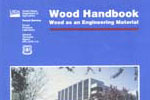 In one particular project, a
high-performance glulam beam was designed
and tested in the laboratory
(click here to see that Forest Service
report). That technology was used by
Anthony Forest Products to create what is
now called the "Power Beam"
(see here). To this day, this is still
the strongest all-wood glulam beam
available in the wood products industry.
In one particular project, a
high-performance glulam beam was designed
and tested in the laboratory
(click here to see that Forest Service
report). That technology was used by
Anthony Forest Products to create what is
now called the "Power Beam"
(see here). To this day, this is still
the strongest all-wood glulam beam
available in the wood products industry.
In addition to the 50+ research reports,
Roland has authored several chapters in
various Wood Engineering textbooks - Glued
Structural Members chapter in the Forest
Service Wood Handbook (2000 version), Wood
Properties section in Mark's Handbook for
Mechanical Engineers, and others.
Then came baseball bats
Having always been a baseball fan, the
idea of applying his wood science and
engineering background to baseball bats has
always been intriguing. It was about 2000,
when he decided to begin a business
relating to wood baseball bats. However,
rather than diving in with a lathe and some
wood blanks, he decided to research what
had been done for the past 100 years. Here
is where his background in (1) Utilization,
(2) Analysis, and (3) Optimization came in
handy.
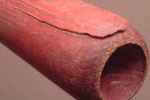 First of all, it was well known that the
most common wood to use was White ash (Fraxinus
americana), a strong wood that has good
resistance to impact strength, and is the
correct density to make desirable weight
baseball bats. Ash has good wood
properties, so it was no surprise that this
was the most popular baseball bat wood in
the past 100 years. Also well known was
that players are supposed to hit "LOGO UP"
with an Ash bat, so that ball contact is
made on the edge-grain. Players knew that
they had to hit on the edge grain to
prevent "flaking". Flaking occurs on Ash
because it is a ring porous species -
repeated contact on the flat-grain results
in the annual rings separating, as shown in
the photo on the right.
First of all, it was well known that the
most common wood to use was White ash (Fraxinus
americana), a strong wood that has good
resistance to impact strength, and is the
correct density to make desirable weight
baseball bats. Ash has good wood
properties, so it was no surprise that this
was the most popular baseball bat wood in
the past 100 years. Also well known was
that players are supposed to hit "LOGO UP"
with an Ash bat, so that ball contact is
made on the edge-grain. Players knew that
they had to hit on the edge grain to
prevent "flaking". Flaking occurs on Ash
because it is a ring porous species -
repeated contact on the flat-grain results
in the annual rings separating, as shown in
the photo on the right.
Another intriguing rule-of-thumb was the
practice of selecting Ash bats that had
approximately 8 to 10 rings per inch. It
was known that bats with these number of
"grains" were stronger than other bats.
Well, through independent research - and
having the convenience of working at the
national laboratory of the Forest Service,
Roland dug up data that showed WHY it is
desirable to select Ash bats having 8 to 10
rings per inch.
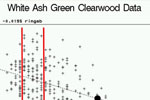 The graph shows rings per inch on the
x-axis versus stiffness of White ash on the
y-axis. This is data on wood blanks that
were tested prior to the 1930's. Note that
as the rings per inch increases, the
stiffness of the tested wood drops. The red
lines show a range of approx. 8 to 12 rings
per inch, and the large dot is centered at
25 rings per inch. There is about a 20%
drop between the data within the red lines,
and the large dot at 25 rings per inch. The
graph for strength shows a similar trend.
The graph shows rings per inch on the
x-axis versus stiffness of White ash on the
y-axis. This is data on wood blanks that
were tested prior to the 1930's. Note that
as the rings per inch increases, the
stiffness of the tested wood drops. The red
lines show a range of approx. 8 to 12 rings
per inch, and the large dot is centered at
25 rings per inch. There is about a 20%
drop between the data within the red lines,
and the large dot at 25 rings per inch. The
graph for strength shows a similar trend.
So, this data shows that the 100-year-old
rule-of-thumb was pretty accurate...
players WILL get good wood if they pick an
Ash bat with approx. 8 to 10 rings per
inch. However, note that this range could
be expanded out to perhaps 8 to 12 rings
per inch.
One new question arose; if ring-porous Ash
bats need to be hit on the edge grain
because the annual rings will "flake" if
hit repeatedly on the flat-grain... then
what about Maple bats? Maple is not a
ring-porous species, it is a diffuse porous
species. "Diffuse-porous" means that there
are NO porous wood layers in each year of
growth. So the question now was, do Maple
bats NEED to be hit on the edge grain? The
answer is NO.
This brings up the next logical question -
if Maple bats do NOT NEED to be hit on the
edge grain, then what would be the
preferred orientation? Again, through
independent research - and the convenience
of working at the national laboratory of
the Forest Service, Roland dug up data that
showed which ORIENTATION is the strongest
when testing wood blanks.
In the 1960s, several species of wood were
tested for toughness (which is similar to
impact bending - like a "karate chop"
test). This was just a basic research
report, but it was perfectly tailored for
wood baseball bats... and was resurrected
by Roland over 40 years later. In that
report, results were convincing that wood
is stronger when contact is made on the
flat grain.
This is even true for Ash. So, the Ash
handle of a baseball bat is stronger when
impact is made on the flat-grain of the
barrel. BUT, edge-grain contact is still
advocated for Ash because the annual rings
in the barrel will fatigue and separate
after repeated hits.
Even MORE INTRIGUING with the data shown in
this chart is that rupture on the bark side
of the wood is stronger than on the
opposite face.
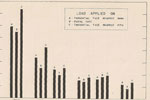 Because of this independent research,
RockBats WAS THE FIRST WOOD BAT COMPANY
THAT ADVOCATED THAT MAPLE BATS BE ORIENTED
FOR FLAT-GRAIN CONTACT... this was 2005.
Because of this independent research,
RockBats WAS THE FIRST WOOD BAT COMPANY
THAT ADVOCATED THAT MAPLE BATS BE ORIENTED
FOR FLAT-GRAIN CONTACT... this was 2005.
Maple bats became popular starting in the
mid-1990's, yet every single bat company
that made maple bats during those years was
placing their logo on the flat-grain, and
advocating edge-grain contact - same as had
been done for 100 years with Ash bats.
No one stopped to asked the question - "I'm
using a different wood, should I be doing
something different?"
If you have wondered, "should I still pick
8 to 12 rings per inch for Maple?" The
answer is NO.
That same data for rings per inch was also
available for Maple, and the data shows
that there is NO considerable drop in
stiffness (and strength).
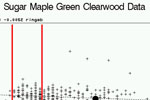 In the data for Maple, that large dot that
sits on the average line at 25 rings per
inch shows that stiffness has less than a
5% drop, compared to the average stiffness
between 8 to 12 rings per inch.
In the data for Maple, that large dot that
sits on the average line at 25 rings per
inch shows that stiffness has less than a
5% drop, compared to the average stiffness
between 8 to 12 rings per inch.
In short, you DON'T NEED TO COUNT YOUR
RINGS ON A MAPLE BAT.
Then came the wood grading
Having worked with the structural
engineered wood products industry, Roland
was deeply involved in the development of
standards and design methodologies for
these wood products. It was a NECESSITY...
these wood products hold up the roof over
our head, so it was important to DESIGN
these wood products to withstand design
loads - and it was important to use
correctly graded lumber to make these
structural wood products.
In the wood bat industry, there were NO
standards for the wood used to make the
bats - not even at the highest level of
game play. So, Roland set out to develop a
wood grading standard of his own - this was
2002.
Wood bats don't have knots, so a wood
grading standard for bat blanks was not
going to be like a structural lumber
standard - which limits the size and
occurrence of knots on the board. A grading
standard for wood bat blanks was going to
be based on grading clear wood... and the
#1 factor that controls the strength of
clear wood is a property called
"slope-of-grain". Basically,
"slope-of-grain" is the angle at which a
piece of wood is cut, relative to the grain
direction growing in the log. For over 100
years, logs were SPLIT to make the staves
that became bat blanks. This was the best
method to consistently produce
straight-grained bat blanks - because split
blanks followed the grain, and this
resulted in baseball bats with
straight-grain.
Maple logs, however, do not split very well
- so these are often sawn at a sawmill.
When you saw a log, you are not following
the grain 100% like when you split a log.
Therefore, wood blanks that are sawn can
have a "slope" to the grain. It is this
"slope" that needs to be controlled,
otherwise, the strength of the baseball bat
is severely reduced.
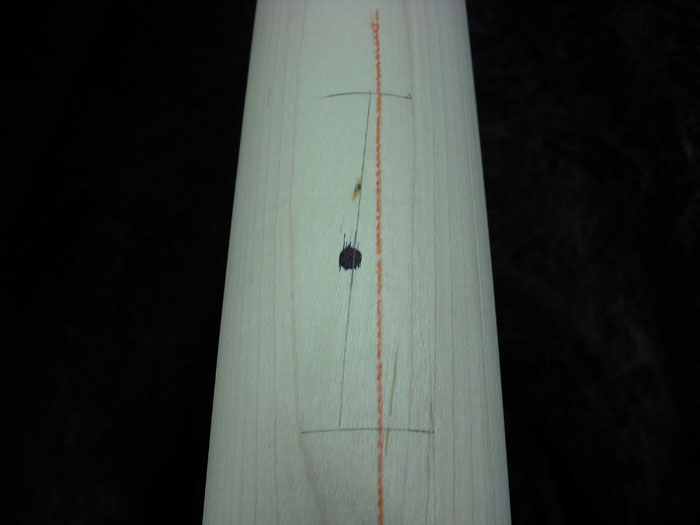
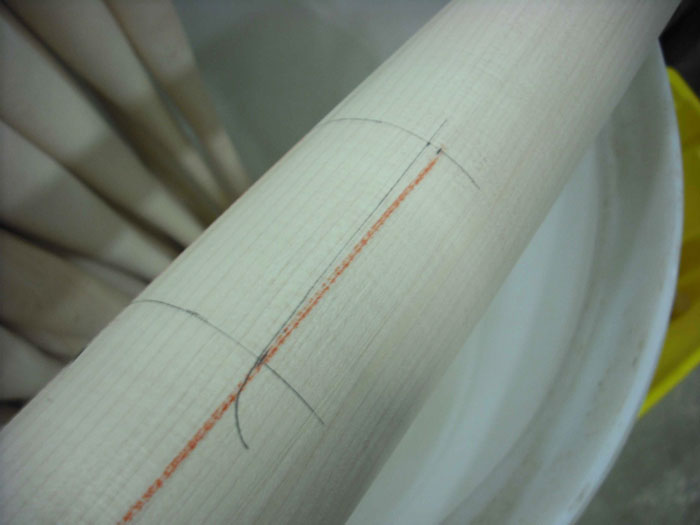 Here are two photos showing the edge grain
(left) and the flat grain (right). The
edge-grain straightness has been graded for
the past 100 years... the straighter the
grain, the stronger the bat. What was NOT
graded for straight grain was the flat
grain face. For Ash wood that had been
split, this was not a problem - because
those blanks had straight-grain due to the
splitting process. But when maple blanks
are SAWN from log, the "slope of grain" on
the flat-grain face is the one that went
unnoticed.
Here are two photos showing the edge grain
(left) and the flat grain (right). The
edge-grain straightness has been graded for
the past 100 years... the straighter the
grain, the stronger the bat. What was NOT
graded for straight grain was the flat
grain face. For Ash wood that had been
split, this was not a problem - because
those blanks had straight-grain due to the
splitting process. But when maple blanks
are SAWN from log, the "slope of grain" on
the flat-grain face is the one that went
unnoticed.
Need to clarify, by SAWING maple logs, you
can still produce top-quality maple blanks
for baseball bats. BUT, you have to apply
additional steps in your processing, which
for Ash - was being taken care of by
splitting the logs. If you are a sawmill
and plan to produce maple blanks, you will
need to grade your planks and cut WITH THE
GRAIN.
Three wood science facts made this
"slope-of-grain" situation escalate into
the broken bat problem often associated
with Maple bats... (1) maple was not
typically split from logs, so this meant
that a significant slope-of-grain could
exist on the flat-grain, (2) wood is
WEAKEST in the plane perpendicular to the
rings, and (3) the impact bending strength
of wood drops dramatically as the angle
from straight-grain increases.
- The photo in the above right shows an
ink spot that bleeds along the grain, and
the red line is the center line that is
down the middle of the round blank.
Because this wood blank was sawn from a
log, there was a slight angle between the
straight piece of wood and the wood grain
within it - this is called
"slope-of-grain" on the flat-grain face.
- When wood failure occurs, it is
usually along the radial planes of the
log - perpendicular to the flat-grain
face. Imagine how you would split a log
of firewood - you split it into "pie"
wedges, because those radial planes are
the WEAKEST planes. When a wood bat
splits apart like in the photo on the
right, it usually splits along the radial
planes - they do NOT break by the annual
rings separating from each other. This is
very important to understand!
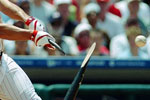
- As the "slope-of-grain" increases, it
severely drops the strength of the bat.
Also, bats that break due to a high
"slope-of-grain" will have the classic
OVAL-SHAPED break like that shown at
right. Bats that have perfect
straight-grained wood do NOT break like
that shown at right.
Why did Maple bats develop into a
problematic "broken bat" issue?
Bats do not break by "slope-of-grain"
because they are Maple, bats break by that
oval-shaped "slope-of-grain" break because
they have a severe angle of grain, with
respect to the centerline of the bat. You
could point to the fact that maple logs
don't split very well (lots of waste), so
manufacturers of bat blanks need to saw the
logs into blanks. Sawing doesn't
"automatically" follow the grain like
splitting does - so if a sawmill doesn't
take care to follow the grain, they will
produce blanks with severe slope-of-grain.
Furthermore, there were no grading rules
that bat makers could follow - so when
purchasing wood blanks to make baseball
bats, they were simply buying CLEAR WOOD
(no knots) and that's it. Lumber grading
standards were based on making furniture,
and the highest grade for furniture was a
CLEAR piece of wood that had no knots.
Further grading CLEAR WOOD for
straight-grain was unheard of.
So, in 2002, Roland developed a wood
grading standard for his own RockBats that
was going to target a limit for
slope-of-grain in wood bats. The core
technology for this system was based on a
relationship called the Hankinson formula.
It was well established in the wood science
industry that the properties of wood
significantly dropped as the angle of grain
changed.
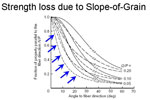 The graph here shows the Hankinson
relationship for several wood properties,
and the impact bending graph is
highlighted. Note that at a 10-degree
angle, the impact bending strength of wood
is only about 35% of the strength of
perfectly straight-grained wood.
The graph here shows the Hankinson
relationship for several wood properties,
and the impact bending graph is
highlighted. Note that at a 10-degree
angle, the impact bending strength of wood
is only about 35% of the strength of
perfectly straight-grained wood.
When sawing logs to obtain maximum yields,
10-degrees is not that unusual of a result
to have in a CLEAR WOOD blank processed
this way.
What level did RockBats choose when
creating their grading standard in 2002?
We wanted an "A+" grade for our RockBats,
so we chose the point of 90% strength on
the Hankinson chart. This is approximately
a 2-degree angle for slope-of-grain.
More intriguing technology
With the wood science established, now
came the engineering that went into the
development of the first RockBats in 2002.
Every ball player knows that a bat has a "sweet
spot", that's the optimum point to make
contact with the baseball. But, where is
the sweet spot? and how do you determine
it's location. Well, by the application of
engineering and physics, RockBats were
developed so that we are the only baseball
bat company to test and identify the
location of the sweet spot on the barrel.
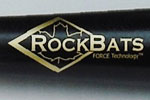 We now had 3 technologies that we believed
would make us the premier wood bat in the
industry: (1) slope-of-grain grading, (2)
flat-grain contact, and (3) sweet spot
testing and identification.
We now had 3 technologies that we believed
would make us the premier wood bat in the
industry: (1) slope-of-grain grading, (2)
flat-grain contact, and (3) sweet spot
testing and identification.
Finally, someone with a wood science and
engineering background stopped to ask the
question... "what's the best way to design
and manufacture a MAPLE baseball bat?".
Our Growth
As is the case with all companies, when
you grow, you cannot do it alone. Our
ownership group expanded from just Roland
and his wife, Elaine - to a well rounded
group of owners that each brought specific
skills to the company.
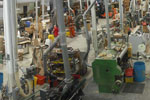 Ben, Mike, and Charlie Zelazoski, of
Zelazoski Wood Products, Inc. in Antigo, WI
are now part owners of RockBats, LLC. This
family-owned wood products manufacturing
facility was founded in 1924 specializing
in brush and broom blocks. When first
contacted by RockBats, there was one copy
lathe - and today, there are 3 lathes (one
with CNC technology). As you can see by the
photo, turning a piece of wood is only a
small facet of what we can do. With the
expertise in manufacturing, RockBats
correctly approached the baseball bat
business using wood science, and
state-of-the-art manufacturing.
Ben, Mike, and Charlie Zelazoski, of
Zelazoski Wood Products, Inc. in Antigo, WI
are now part owners of RockBats, LLC. This
family-owned wood products manufacturing
facility was founded in 1924 specializing
in brush and broom blocks. When first
contacted by RockBats, there was one copy
lathe - and today, there are 3 lathes (one
with CNC technology). As you can see by the
photo, turning a piece of wood is only a
small facet of what we can do. With the
expertise in manufacturing, RockBats
correctly approached the baseball bat
business using wood science, and
state-of-the-art manufacturing.
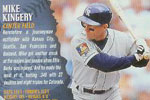 Mike and Christy Kingery came on board as
the Major League connection. Mike had 17
years of professional baseball experience
as an outfielder with the Kansas City
Royals, Seattle Mariners, San Francisco
Giants, Oakland A's, Colorado Rockies and
Pittsburgh Pirates. Upon retiring as a
Major League player, Mike returned to his
hometown and created Solid Foundation
Baseball School, Inc. to answer strong
demand from local baseball teams and
players. Mike has trained professional
baseball instructors using hands-on
instruction techniques he learned in the
big leagues, helping players maximize their
abilities and understand the basic
fundamentals of the game. When RockBats
develops a new baseball bat design, all
prototype bats are placed in Mike's hands
to be evaluated for its performance and
feel.
Mike and Christy Kingery came on board as
the Major League connection. Mike had 17
years of professional baseball experience
as an outfielder with the Kansas City
Royals, Seattle Mariners, San Francisco
Giants, Oakland A's, Colorado Rockies and
Pittsburgh Pirates. Upon retiring as a
Major League player, Mike returned to his
hometown and created Solid Foundation
Baseball School, Inc. to answer strong
demand from local baseball teams and
players. Mike has trained professional
baseball instructors using hands-on
instruction techniques he learned in the
big leagues, helping players maximize their
abilities and understand the basic
fundamentals of the game. When RockBats
develops a new baseball bat design, all
prototype bats are placed in Mike's hands
to be evaluated for its performance and
feel.
Dave Bruns and Chuck Steinhauer. Dave Bruns
joined the RockBats group as the veteran
sales professional who will be handling all
retail Dealers and expansion of RockBats
into YOUR neighborhood sporting goods
store. Dave has been an executive at many
levels. His sales and leadership experience
includes time with Procter & Gamble and
Memorex-Telex, among others. Chuck
Steinhauer is the business professional who
is assisting RockBats with our expected
exponential growth in the coming years.
Chuck credits his ability to help
busiensses survive and compete in today's
market by "being on the technological edge
and running an efficient operation".
2007 Season
After 17 years, Roland decided to leave
his government job and pursue running his
business full time - RockBats. He truly
believed that he had developed THE BEST
Maple bat in the industry - through wood
science and engineering, there was NO OTHER
bat company that could match the
technologies that RockBats brought to the
table.
RockBats may not have been the first
company to make maple bats, but they were
the first to do it right.
2008 Season
Long story short; research was conducted
by the major leagues in 2008, and it was
confirmed that "slope-of-grain" was the way
to go for grading baseball bat blanks. AND,
it was confirmed that Maple baseball bats
are truly stronger when hit on the
flat-grain face. SO, Bat Supplier
Regulations were changed for the 2009
season to include the following
technologies:
- The "slope-of-grain" grading for
baseball bat wood was a requirement for
all manufacturers - with a maximum
allowed slope of approx. 3-degrees on
both the edge and flat-grain face. This
technology is most recognized by the ink
spot that is now on every maple (and
birch) bat in the major leagues.
- Flat-grain grain contact is now
required for ALL bat manufacturers that
are supplying the major leagues. Thus,
the 100-year-old rule-of-thumb to place
logos on the flat grain was now changed
to the edge grain for maple (and birch)
bats - to advocate flat-grain contact.
Just like in Roland's days of being a
government research scientist, it took
years of research before finally seeing
results translated into implementation by
the industry.
2009 Season
After all the new bat regulations were
adopted by the major leagues, RockBats
chose NOT to pursue certification for
supplying bats to the major leaguers in
2009. Therefore, Roland contacted
Milwaukee's professional team to conduct
independent consulting - as a wood
scientist. By grading and rating every wood
bat received by the team, this resulted in
that team having the fewest 2-piece broken
bats out of all 30 major league teams. That
year demonstrated the levels that could be
achieved for increased safety and
performance - due to the application of
wood science in the clubhouse.
2010 Season
RockBats chose to pursue certification
in 2010, and chose to ONLY work with
Milwaukee's professional team that year.
Much like Roland's scientific approach to
conducting research projects, careful steps
were taken to demonstrate the technology
that RockBats had to offer. Bat shape
re-designs specific to the player's needs,
and commitment to quality for professional
players was the goal. By mid-season, we had
12 professional players from Milwaukee's
professional team order RockBats.
On June 26th, 2010, RockBats appeared on
the front page of the
Milwaukee Journal Sentinel.
On June 29th, 2010 - 6 of 9 starters for
Milwaukee's professional team went up to
bat with a RockBat.
In the July All-Star game, Milwaukee's two
position players that were invited to the
2010 All-Star game (Ryan Braun and Corey
Hart) both used their RockBats. Corey Hart
was also invited to the HR Derby, and had a
tremendous showing in his first round
performance.
Read more about Corey Hart's Home Run Derby
performance.
Overall, a great season.
2011 Season
In 2011, RockBats visited with major
league teams during Spring Training in AZ.
Our approach was to offer an
engineering-based approach to supplying
wood bats for professional players. Swing
Weight Analysis, coupled with bat shape
design, resulted in matching bats to
professional players that offered optimum
performance. We worked with the Colorado
Rockies and by season's end, we had 10
players total who had tried RockBats - this
included players like Tulowitzki, Helton,
Giambi, Gonzalez, and others.
RockBats also grew in the international
scene - with our international
certification in place, we now have bats
used by teams and leagues in Europe and
Asia.
In the U.S., we have a growing list of
leagues and teams that are switching to
RockBats. As players learn more about wood
quality and its importance to the
performance of a wood bat - RockBats
becomes the obvious choice.
Our trend of ADVANCING the state-of-the-art
continues into 2012.
Testing
All of our RockBat models have passed one
final stage - player testing and feedback.
Even with all of the advanced processes that
we described above, we still made sure that
our bat models were tested by actual players
at all levels of play. Even our Youth bat
models were tailored toward young players who
are only used to swinging -10 aluminum. In
all cases, we were not completely satisfied
with the final design of each of our bat
models until we achieved a feedback rating of
"WOW".
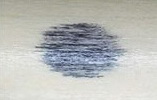
Look for the INK SPOT>>>>> |
|
|
|
|
Mid Willamette Valley
Albany, Amity, Aurora, Brooks, Canby, ,
Corvallis, Coburg, Cottage Grove, Creswell,
Dallas, Dayton, Dundee, Falls City, Gates,
Gervais, Halsey, Harrisburg, Independence,
Jefferson, Junction City, Keizer, Lebanon,
Lowell, Lyons, McMinnville, Mill City, Molalla,
Newberg, Oakridge, Salem, Scio, Sheridan,
Silverton, Springfield, Stayton, St. Paul,
Sublimity, Tangerit, Veneta, Waterloo, Willamina,
Woodburn, Yamhill |
Portland and Vicinity
Banks, Barlow, Beaverton, Camas, Canby,
Clackamas, Clatskanie, Columbia City, Cornelius,
Forest Grove, Gaston, Gresham, Happy Valley,
Hillsboro, Lake Oswego, Marquam, Milwaukie,
Molalla, North Plains, Oregon City, Portland,
Rainier, Sandy, Scappoose, St. Helens, Tigard,
Troutdale, Tualatin, Vernonia, West Linn,
Wilsonville |
Southwest Washington
Cities
Aberdeen, Battle Ground, Camas, Castle Rock,
Cathlamet, Central Park, Centralia, Chehalis,
Chinook, Cosmopolis, Elma, Ilwaco, Kelso, Kalama,
Long Beach, Longview, McCleary, Montesano,
Nahcotta, Naselle, Oakville, Ocean Park, Ocean
Shores, Pe Ell, Raymond, Salkum, Seaview,
Silverlake, Skamokawa, South Bend, Tokeland,
Vancouver |
|
We
deliver
Nationwide
but
SOLD IN THE UNITED STATES ONLY
Alabama, Alaska, Arizona, Arkansas, California,
Colorado, Connecticut, Delaware, District Of
Columbia, Washington DC, Florida, Georgia,
Hawaii, Idaho, Illinois, Indiana, Iowa, Kansas,
Kentucky, Louisiana, Maine, Maryland,
Massachusetts, Michigan, Minnesota, Mississippi,
Missouri, Montana, Nebraska, Nevada, New
Hampshire, New Jersey, New Mexico, New York,
North Carolina, North Dakota, Ohio, Oklahoma,
Oregon, Pennsylvania, Rhode Island, South
Carolina, South Dakota, Tennessee, Texas, Utah,
Vermont, Virginia, Washington, West Virginia,
Wisconsin, and Wyoming Cities: Los Angeles, San
Francisco, San Jose, San Diego, Orlando Miami,
Washington, Dallas, Houston, Boston, Washington
DC, Irvine, Phoenix, Las Vegas, Omaha, New York
city, Reno, Tucson, Denver, Seattle, Tacoma,
Ventura, Southern California, San Antonio,
Sacramento, Kansas City, Richmond, Tampa bay,
Chicago, Hudson Valley, Orange County, Salt lake
City, Nashville, Pittsburg, Charlotte, Palm
Beach, Jupiter, Atlantic City, Ontario, Anaheim |
|
|
|